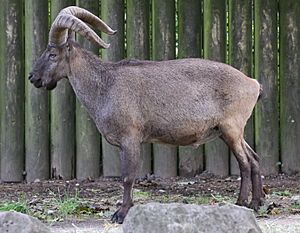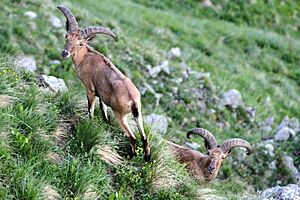East Caucasian tur facts for kids
Quick facts for kids East Caucasian tur |
|
|---|---|
 |
|
| At Zoo Augsburg | |
| Conservation status | |
| Scientific classification | |
| Genus: |
Capra
|
| Species: |
cylindricornis
|
The East Caucasian tur (Capra cylindricornis), also called the Daghestani tur, is a type of wild goat. These animals live in the mountains of the eastern Greater Caucasus. You can find them in Azerbaijan, Georgia, and European Russia. They like to live in rocky, high places. Turs mostly eat grasses and leaves. They are listed as near threatened, which means their numbers are getting low.
Contents
What They Look Like
East Caucasian turs look like goats. They have big, narrow bodies and short legs. Males and females look quite different, especially in size and horns. This is called sexual dimorphism.
Adult male turs stand about 105 cm (41 in) tall at the shoulder. They are about 190 cm (75 in) long from head to body. Males can weigh around 140 kg (309 lb). Females are smaller. They are about 85 cm (33 in) tall and 138 cm (54 in) long. Females weigh only about 56 kg (123 lb).
Males have horns that curve slightly like a lyre. These horns can be 70 to 90 cm (28 to 35 in) long. Female horns are much shorter, usually 20 to 22 cm (7.9 to 8.7 in) long.
Their summer fur is short and sandy-yellow. Their bellies are a dirty white color. They also have dark brown stripes on the front of their legs and on their tails. In winter, females and young males get slightly grayish fur. But adult males have solid dark brown winter coats. They don't have stripes on their legs in winter.
Male turs grow a beard in their second year. This beard gets longer as they get older. By age four or five, it can be about 12 cm (4.7 in) long. Unlike other goats, their beards are stiff and stick out. Females usually have a very small beard or none at all. Males also lose their beard in the summer.
Where They Live and Their Home
East Caucasian turs only live in the Greater Caucasus Mountains. They can be found from 800 to 4,000 meters (2,600 to 13,100 ft) above sea level. Their home stretches from Mount Shkhara in Georgia to Mount Babadag in Azerbaijan. It's not clear exactly where their home ends in the west. This is because their area overlaps with the West Caucasian tur.
Most turs stay away from people. They live in very rough, open mountain areas around 3,000 meters (9,800 ft) high. If there are not many people around, turs might live in gentler, lower areas.
How They Live
Having Babies
East Caucasian turs usually breed from late November to early January. The babies are born in May and June. A mother tur is pregnant for about 160 to 165 days.
Newborn turs weigh about 3.4 to 4.1 kg (7.5 to 9.0 lb). Most often, a mother has one baby. But sometimes, about 3% of the time, she will have twins. Young turs are very quick and can climb steep slopes just one day after birth. They start to nibble on grass after about a month. But they continue to drink their mother's milk until December.
Turs grow slowly. Females reach their full size around five years old. Males take even longer, reaching full size at about 10 or 11 years old. Females can have babies when they are two years old. But in the wild, they usually don't breed until they are four.
East Caucasian turs can have babies with West Caucasian turs. They can also breed with domestic goats. Their babies can also have their own young. But this doesn't happen often in the wild.
What They Eat
In warmer months, turs eat throughout the late afternoon, night, and morning. They rest during the hottest parts of the day in shady spots. In winter, they might stay in open fields all day. They will eat and rest in turns. They can travel 15 to 20 km (9.3 to 12.4 mi) each day.
Turs eat almost any plants they can find. In spring and summer, they prefer forbs (flowering plants that are not grass). In autumn and winter, they eat grasses, trees, and shrubs.
They move up and down the mountains with the seasons. This is called seasonal migration. They move up about 1,500 to 2,000 meters (4,900 to 6,600 ft) in May. Then they move back down in October. Adult males usually live higher up than females and their young. They come down to join the females during the breeding season. In summer, turs also move up and down daily. They can move as much as 1,000 meters (3,300 ft) vertically. They go between feeding areas and places where they rest at night.
During the breeding season, males compete to find a mate. Older males are stronger than younger ones. They scare away younger males with threatening moves. Sometimes they rush at them or clash horns. Fights between males of the same size are more intense. They might stand on their back legs and butt heads with their horns. They can wrestle with their horns, sometimes rolling down hills. This continues until one male gives up and leaves the group. During this time, males also mark their area. They rub their scent on tree trunks and branches.
Outside of the breeding season, female turs live in steady groups. These groups have about seven turs, including some young males. Older males live in bigger groups of only males. These groups have about 12 members. Some younger males travel in groups of two or three. These male groups break up around November when breeding starts. Then, groups with both males and females form. They go back to single-sex groups in January or February. In protected areas, you might find between 5 and 16 turs per square kilometer.



